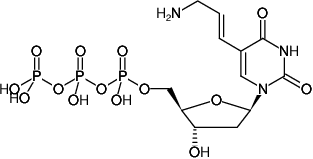Aminoallyl-dUTP - Solution
5-(3-Aminoallyl)-2'-deoxyuridine-5'-triphosphate, Sodium salt
| Catálogo Nº | Apresentação | Preço (R$) | Comprar |
|---|---|---|---|
| NU-803S | 10 μl (100 mM) | Sob demanda | Adicionar ao Carrinho |
| NU-803L | 5 x 10 μl (100 mM) | Sob demanda | Adicionar ao Carrinho |
| NU-803XL | 100 μl (100 mM) | Sob demanda | Adicionar ao Carrinho |

For general laboratory use.
Envio: shipped on gel packs
Condições de armazenamento: store at -20 °C
Short term exposure (up to 1 week cumulative) to ambient temperature possible.
Validade: 12 months after date of delivery
Fórmula molecular: C12H20N3O14P3 (free acid)
Peso molecular: 523.22 g/mol (free acid)
CAS#: 116840-18-7
Pureza: ≥ 95 % (HPLC)
Forma: solution in water
Concentração: 100 mM - 110 mM
pH: 7.5 ±0.5
Propriedades espectroscópicas: λmax 289 nm, ε 7.1 L mmol-1 cm-1 (Tris-HCl pH 7.5)
Formulários:
Incorporation into DNA/cDNA by
- PCR with Taq polymerase[1], in-house data
- Nick Translation with DNAse I/ DNA Polymerase I[2]
- Primer Extension with Klenow exo- [3]
- 3'-End Labeling with Terminal deoxynucleotidyl Transferase (TdT)[4]
- Reverse Transcription with MMLV Reverse Transcriptase[2]
Descrição:
Aminoallyl-dUTP is recommended for two-step labeling of DNA/cDNA e.g. by PCR, Nick Translation, Primer Extension, 3'-End Labeling and Reverse Transcription. It is enzymatically incorporated into DNA/cDNA as substitute for its natural counterpart dTTP. The resulting Amine-functionalized DNA/cDNA can subsequently be labeled via the classic Amine/NHS Ester reaction that offers the choice to introduce a Biotin group (via NHS Ester of Biotin) for subsequent purification tasksto introduce fluorescent group (via NHS Ester of fluorescent dyes) for subsequent microscopic imaging
Referências selecionadas:
[1] Dirsch et al. (2007) Probe production for in situ hybridization by PCR and subsequent covalent labeling with fluorescent dyes. Appl. Immunohistochem. Mol. Morphol. 3:332.
[2] Cox et al. (2004) Fluorescent DNA hybridization probe preparation using amine modification and reactive dye coupling. BioTechniques 36:114.
[3] Cherkasov et al. (2010) New Nucleotide Analogues with Enhanced Signal Properties. Bioconjugate Chem. 21 (1):122.
[4] Unciti-Broceta et al. (2003) The use of solid supports to generate nucleic acid carriers.Accounts of Chemical Research 45:1140.
